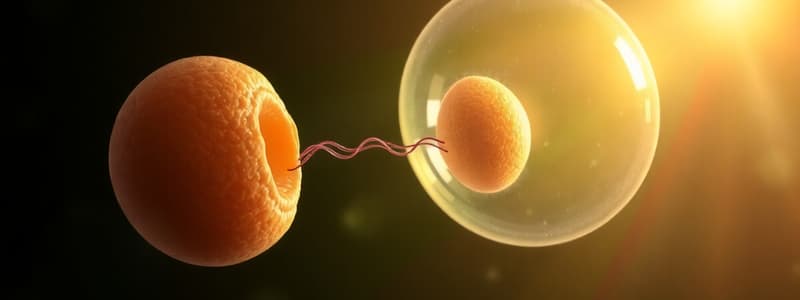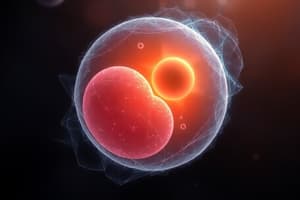Podcast
Questions and Answers
¿Qué ocurre durante la segmentación del cigoto?
¿Qué ocurre durante la segmentación del cigoto?
- No se requiere la implantación para continuar dividiéndose.
- Se generan blastómeros con el mismo citoplasma inicial. (correct)
- Se produce un aumento en el tamaño celular.
- El cigoto se convierte en un embrión completo.
¿Cuál es el estado del cigoto aproximadamente 30 horas después de la fecundación?
¿Cuál es el estado del cigoto aproximadamente 30 horas después de la fecundación?
- Mórula.
- Blastocisto.
- Fase de cuatro células.
- Cigoto unicelular. (correct)
¿Qué función tiene la masa celular externa (MCE) durante el desarrollo embrionario?
¿Qué función tiene la masa celular externa (MCE) durante el desarrollo embrionario?
- Desarrollar los órganos del embrión.
- Establecer el primer contacto maternofilial. (correct)
- Formar parte del embrión.
- Transformarse en el disco embrionario.
¿Qué sucede con el cigoto si no se realiza la implantación?
¿Qué sucede con el cigoto si no se realiza la implantación?
¿Qué representa la blástula en el desarrollo embrionario?
¿Qué representa la blástula en el desarrollo embrionario?
¿Qué se convierte la masa celular interna (MCI) en el desarrollo embrionario?
¿Qué se convierte la masa celular interna (MCI) en el desarrollo embrionario?
¿Qué componente del blastocisto se encarga de perforar la pared uterina?
¿Qué componente del blastocisto se encarga de perforar la pared uterina?
¿Cuál es el resultado de la segmentación en el cigoto?
¿Cuál es el resultado de la segmentación en el cigoto?
Flashcards
Segmentación (Embrión)
Segmentación (Embrión)
El proceso de división celular que ocurre en el cigoto después de la fecundación, dando lugar a blastómeros con el mismo citoplasma inicial.
Tiempo de la segmentación
Tiempo de la segmentación
La segmentación en el embrión se da a medida que el cigoto viaja por la trompa de Falopio hacia el útero. La distancia recorrida indica el tiempo que lleva el proceso.
Blástula/Blastocisto
Blástula/Blastocisto
Estructura embrionaria que se forma en el día 4-5 del desarrollo, caracterizada por una cavidad interna, el blastocele.
Masa Celular Externa (MCE)
Masa Celular Externa (MCE)
Signup and view all the flashcards
Masa Celular Interna (MCI)
Masa Celular Interna (MCI)
Signup and view all the flashcards
Implantación
Implantación
Signup and view all the flashcards
Día 6° del desarrollo
Día 6° del desarrollo
Signup and view all the flashcards
Diferenciación
Diferenciación
Signup and view all the flashcards
Study Notes
Segmentation and Nidation
- In identical twins, cell segmentation occurs very early, while in Siamese twins, it occurs later.
- The zygote, after becoming a two-cell structure, undergoes repeated mitotic divisions, increasing the number of cells (blastomeres).
- The initial cytoplasm is shared among the cells, but as division continues, the cytoplasm becomes less abundant.
- Cell division stops unless implantation occurs due to insufficient cytoplasm.
- The distance traveled from the fallopian tube is critical in determining the timing.
- Zygote segmentation into blastomeres begins approximately 30 hours post-fertilization.
Stages
- Day 0: Zygote (single cell)
- Days 1-4: Morula (16-32 cells)
- Days 4-5: Blastula/Blastocyst/Blastocoele
Blastocyst Formation
- The morphology changes due to fluid accumulation.
- Blasto = immature, Cysto = cavity/space
- The blastula appears around the fifth day, free-floating in the uterine cavity.
- The outer layer (MCE) is responsible for implantation and uterine wall penetration.
- The MCE eventually develops into the trophoblast, the initial nutritive support system.
- The inner layer (MCI) becomes the developing embryo itself. (embryonic disk)
- The MCE is essential but not part of the embryo, it's temporary
- The embryo is primarily MCI.
Second Week Development
- The blastocyst implants on the endometrial lining around day 6.
- The blastocyst differentiates into two structures, the trophoblast (MCE) and inner cell mass (MCI) or embryoblast.)
- The inner cell mass (MCI) or embryoblast eventually develops into the embryonic disc.
- The MCI forms the embryonic disk, the structure that becomes the embryo itself.
- Day 8-10: Gastrulation
- The growing trophoblast differentiates into two layers: the cytotrophoblast and the syncytiotrophoblast.
- The inner cell mass (MCI) differentiates further into two layers: hypoblast and epiblast, forming a bilaminar embryonic disc.
- Two cavities develop in the gastrula: the yolk sac (from the blastocoele) lined by the hypoblast, and the amniotic sac (new cavity) lined by the epiblast.
Studying That Suits You
Use AI to generate personalized quizzes and flashcards to suit your learning preferences.




